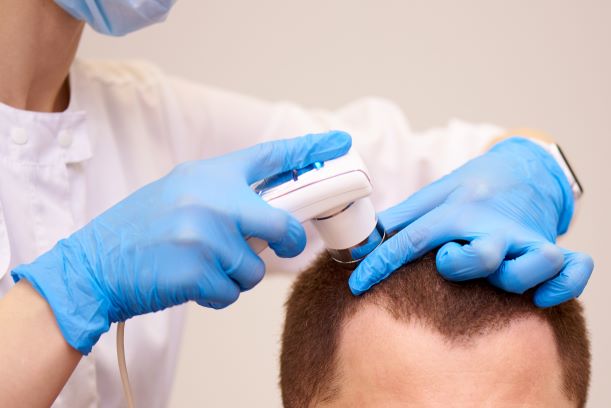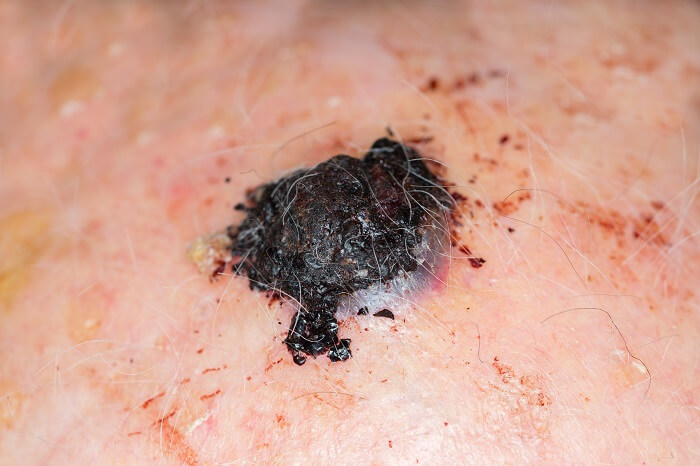Melanoma is one of the most serious forms of cancer, and because its appearance can closely mimic natural moles, freckles, and age spots, it can be easy to overlook. It’s important to know what to look for and perform regular skin cancer screenings to ensure you receive treatment for this condition in the earliest stages. According to Dr. Gregory Walker of U.S. Dermatology Partners in Waco, Texas, “Melanoma can be easily overlooked in obvious places on the body, but many people don’t know that the scalp, fingernails and toenails, and other harder to see areas often hide this condition until it has progressed to more advanced stages. Patients who know what to look for and regularly screen their skin for cancers, are much more likely to receive a diagnosis in early, more treatable stages.” Keep reading to hear more from Dr. Walker about what scalp melanoma looks like and how to check for this condition and prevent serious health concerns.
What is Scalp Melanoma?
Melanoma is a serious and potentially deadly form of skin cancer. It is more likely to spread locally as well as metastasize (spread to other parts of the body), and it accounts for more skin cancer-related deaths than basal and squamous cell carcinomas combined. Melanoma takes its name from melanocytes, the skin’s pigment-producing cells, where this condition originates. All types of melanoma are more likely to spread to lymph nodes and other tissues, but on the scalp, there are numerous blood vessels and other tissues that can quickly be impacted by melanoma cells.
According to Dr. Walker, “The good news is that scalp melanoma is one of the rarest forms of this cancer, accounting for less than 5% of melanoma cases. The bad news is that scalp melanoma tends to be a more severe prognosis than other forms of melanoma. However, research indicates that this is largely because of how late in development it’s typically diagnosed. Simply put, people are more likely to overlook this condition until it’s very advanced, making it more difficult to treat.”
What Does Scalp Melanoma Look & Feel Like?

The first step to finding scalp melanoma is simple – you need to know what you’re looking and feeling for. Melanoma on any area of the skin usually looks like common skin conditions, which is one of the main reasons why it’s overlooked on other parts of the body. Melanomas may be mistaken for warts, moles, freckles, age spots, ulcers, or sores, and in some cases, they grow out of pre-existing skin growths. Melanoma lesions may bleed regularly, feel painful, or tingle.
To differentiate between benign skin lesions and potential scalp melanoma, keep the ABCDEs of skin cancer in mind:
- A – Asymmetry – Are the sides of the mole the same, or are they noticeably different?
- B – Border – Do the edges of the spot look jagged or otherwise atypical?
- C – Color – Is the color different from other spots on your body, or does the color vary throughout the lesion?
- D – Diameter – Is the mole larger than 6 mm (the size of a pencil eraser)?
- E – Evolution – Is the mole changing in any way (size, color, shape, texture)?
What are the Causes of & Risk Factors for Scalp Melanoma?
Sun exposure is the leading cause of all forms of melanoma. Because the scalp often receives a significant amount of sun exposure, that means there is a high risk for melanoma and other forms of skin cancer in this area. In addition to sun exposure, regularly visiting tanning beds, radiation treatment, and chemical exposure can all contribute to the development of skin cancers.
In addition to the underlying causes of skin cancer, numerous factors can increase the risk of developing scalp melanoma, including:
- Taking immunosuppressive medications
- Having fair skin and light-colored eyes
- Having freckled skin or numerous moles
- Having a family history of skin cancer
- Having excessive or prolonged sun exposure or frequent sunburns
- Living at higher altitudes
What Treatments are Available for Scalp Melanoma?
According to Dr. Walker, “Each person’s treatment plan for scalp melanoma will be different. The stage of cancer, how far it’s spread, and whether or not it’s metastasized will all factor into the treatment plan. During a consultation visit, the patient will be carefully examined visually, we’ll run any tests, and we’ll talk about their symptoms. Once we have all of the necessary information, we’ll partner with the patient to develop an effective treatment plan. If necessary, we may also partner with an oncologist, a doctor specializing in cancer, to ensure the patient receives the best possible treatment.” Some of the common treatments used to address scalp melanoma include:
- Surgical excision – The use of a scalpel to remove the cancer cells and a small amount of surrounding tissue to ensure no cancerous cells remain. This may be followed by additional biopsies or studies to ensure cancer has not spread, followed by restorative procedures like skin flaps or grafts.
- Radiation and chemotherapy – Typically performed by an oncologist or in partnership with a cancer specialist, these procedures are used to kill remaining cancer cells, especially when cancer has spread to a large area of the skin or metastasized into other parts of the body.
Can I Prevent Scalp Melanoma?
According to Dr. Walker, “It’s always best to take steps to prevent a problem rather than waiting for something to arise before seeking treatment. Because the sun is the leading cause of melanoma, sun protection is extremely important, but it can be more difficult to keep the scalp safe than other parts of the skin. Wearing a hat, bandana, or other head coverings can help. If you have a part in your hair, are balding, or otherwise have large areas of the exposed scalp, you should apply sunscreen. One of the easiest solutions is to minimize your time out in the sun whenever possible. Finally, make sure to check your scalp and whole body regularly for signs of melanoma, and don’t forget to look at your scalp. Use flashlights and mirrors as needed to take a closer look at any hard to see areas. You should also visit your dermatologist routinely for a professional skin exam.”
Can Other Forms of Cancer Appear on the Scalp?
In addition to melanoma, other forms of skin cancer can also develop on the scalp, including the two most common forms of skin cancer, basal, and squamous cell carcinoma. Basal cell carcinoma is the most common form of skin cancer. It can be very damaging to the skin it affects, but it very rarely metastasizes. Basal cell carcinoma tumors have a variety of appearances from white or silvery bumps with a waxy texture to highly visible blood vessels. These lesions may be flesh-toned, brown, or black in color. Squamous cell carcinoma is also a common form of skin cancer on the scalp. It is more likely to spread than basal cell carcinoma, but it tends to evolve slowly. It often looks like a red bump or thick skin growth that may bleed easily or sores that don’t heal easily.
Visit U.S. Dermatology Partners
If you’re concerned about possibly cancerous skin cells or it’s time for your annual exam, don’t hesitate to reach out to U.S. Dermatology Partners. You can get started scheduling your appointment by using our simple online request form.
Find a location near me
or



